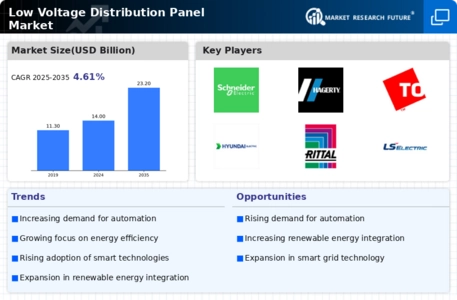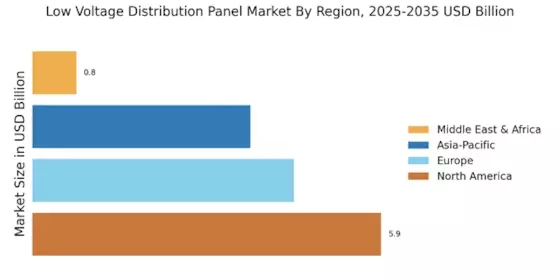Rising Demand for Energy Efficiency
The Low Voltage Distribution Panel Market is experiencing a notable increase in demand for energy-efficient solutions. As energy costs continue to rise, consumers and businesses are seeking ways to reduce their energy consumption. This trend is further supported by government initiatives aimed at promoting energy efficiency. For instance, various regions have implemented regulations that encourage the adoption of energy-efficient technologies. The market for low voltage distribution panels is projected to grow as these panels are designed to optimize energy usage, thereby reducing operational costs. In fact, the energy efficiency segment is expected to account for a significant share of the market, indicating a shift towards more sustainable energy practices. This growing awareness of energy efficiency is likely to drive innovation and investment in the Low Voltage Distribution Panel Market.
Expansion of Renewable Energy Sources
The Low Voltage Distribution Panel Market is poised for growth due to the increasing integration of renewable energy sources. As countries strive to meet their renewable energy targets, the demand for low voltage distribution panels is expected to rise. These panels play a crucial role in managing the distribution of electricity generated from renewable sources such as solar and wind. The transition towards renewable energy is not only a response to environmental concerns but also a strategic move to enhance energy security. According to recent data, the renewable energy sector is anticipated to expand significantly, which will, in turn, bolster the demand for low voltage distribution panels. This trend suggests that manufacturers in the Low Voltage Distribution Panel Market may need to adapt their products to accommodate the unique requirements of renewable energy integration.
Increased Focus on Safety and Compliance
Safety and compliance are paramount considerations in the Low Voltage Distribution Panel Market. As electrical systems become more complex, the need for adherence to safety standards and regulations has intensified. Governments and regulatory bodies are implementing stringent guidelines to ensure the safe operation of electrical installations. This focus on safety is driving the demand for low voltage distribution panels that meet or exceed these compliance requirements. Manufacturers are increasingly investing in technologies that enhance the safety features of their products, such as overload protection and fault detection systems. The market is likely to benefit from this heightened emphasis on safety, as consumers prioritize reliable and compliant electrical solutions. Consequently, the Low Voltage Distribution Panel Market is expected to see growth as stakeholders respond to the evolving landscape of safety regulations.
Urbanization and Infrastructure Development
Urbanization is a driving force behind the growth of the Low Voltage Distribution Panel Market. As urban areas expand, there is an increasing need for robust electrical infrastructure to support residential, commercial, and industrial developments. The demand for low voltage distribution panels is likely to surge as new buildings and facilities require efficient power distribution systems. Additionally, infrastructure development projects, such as transportation and public utilities, are expected to further stimulate market growth. According to recent projections, urbanization trends indicate that a significant portion of the population will reside in urban areas by 2030, necessitating the installation of advanced electrical systems. This urban shift presents a substantial opportunity for stakeholders in the Low Voltage Distribution Panel Market to cater to the growing demand for reliable and efficient power distribution solutions.
Technological Advancements in Electrical Infrastructure
Technological advancements are significantly influencing the Low Voltage Distribution Panel Market. Innovations in smart grid technology and automation are reshaping how electricity is distributed and managed. These advancements enable more efficient monitoring and control of electrical systems, which is essential for modern infrastructure. The integration of smart technologies into low voltage distribution panels allows for real-time data analysis and improved operational efficiency. As a result, the market is witnessing a shift towards more sophisticated distribution panels that can handle complex electrical loads. Furthermore, the adoption of digital solutions is expected to enhance the reliability and safety of electrical systems. This trend indicates that companies within the Low Voltage Distribution Panel Market must invest in research and development to stay competitive and meet the evolving needs of consumers.


















Leave a Comment